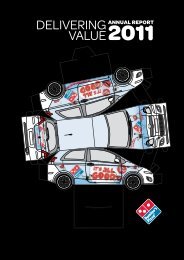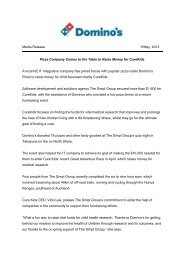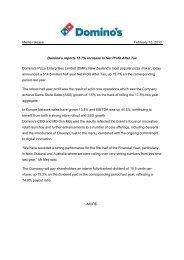2012 Annual Report - Domino's Pizza
2012 Annual Report - Domino's Pizza
2012 Annual Report - Domino's Pizza
Create successful ePaper yourself
Turn your PDF publications into a flip-book with our unique Google optimized e-Paper software.
NOTES TO THE FINANCIAL STATEMENTS CONTINUED<br />
3.6 Foreign currencies<br />
The individual financial statements of each<br />
group entity are presented in its functional<br />
currency being the currency of the primary<br />
economic environment in which the entity<br />
operates (its functional currency). For<br />
the purpose of the consolidated financial<br />
statements, the results and financial position<br />
of each entity are expressed in Australian<br />
dollars (‘$’), which is the functional<br />
currency of Domino’s <strong>Pizza</strong> Enterprises<br />
Limited and the presentation currency for<br />
the consolidated financial statements.<br />
In preparing the financial statements of the<br />
individual entities, transactions in currencies<br />
other than the entity’s functional currency<br />
(foreign currencies) are recognised at the<br />
rates of exchange prevailing on the dates of<br />
the transactions. At the end of each reporting<br />
period, monetary items denominated in<br />
foreign currencies are retranslated at the rates<br />
prevailing at that date. Non-monetary items<br />
carried at fair value that are denominated<br />
in foreign currencies are retranslated at the<br />
rates prevailing on the date when the fair<br />
value was determined. Non-monetary items<br />
that are measured in terms of historical cost<br />
in a foreign currency are not retranslated.<br />
Exchange differences are recognised in profit or<br />
loss in the period in which they arise except for:<br />
• exchange differences on foreign currency<br />
borrowings relating to assets under<br />
construction for future productive use, which<br />
are included in the cost of those assets when<br />
they are regarded as an adjustment to interest<br />
costs on those foreign currency borrowings;<br />
• exchange differences on transactions<br />
entered into in order to hedge certain<br />
foreign currency risks (see 3.24 below<br />
for hedge accounting policies); and<br />
• exchange differences on monetary items<br />
receivable from or payable to a foreign<br />
operation for which settlement is neither<br />
planned or likely to occur, (therefore forming<br />
part of the net investment in a foreign<br />
operation), which are recognised initially in<br />
other comprehensive income and reclassified<br />
from equity to profit and loss on disposal<br />
or partial disposal of the net investment.<br />
For the purpose of presenting the consolidated<br />
financial statements, the assets and liabilities<br />
of the Consolidated entity’s foreign operations<br />
are expressed in Australian dollars using<br />
exchange rates prevailing at the end of the<br />
reporting period. Income and expense items<br />
are translated at the average exchange rates<br />
for the period, unless exchange rates fluctuated<br />
significantly during the period, in which case the<br />
exchange rates at the date of the transactions<br />
are used. Exchange differences arising, if<br />
any, are recognised in other comprehensive<br />
income and accumulated in equity (attributed<br />
to non-controlling interests as appropriate).<br />
On disposal of a foreign operation (i.e. a disposal<br />
of the Consolidated entity’s entire interest in<br />
a foreign operation, or a disposal involving<br />
loss of control over a subsidiary that includes<br />
a foreign operation, loss of joint control over a<br />
jointly controlled entity that includes a foreign<br />
operation, or loss of significant influence over<br />
an associate that includes a foreign operation),<br />
all of the accumulated exchange differences<br />
in respect of that operation attributable to<br />
the Consolidated entity are reclassified to<br />
profit or loss. Any exchange differences that<br />
have previously been attributed to noncontrolling<br />
interests are derecognised, but<br />
they are not reclassified to profit or loss.<br />
In the case of a partial disposal (i.e. no loss<br />
of control) of a subsidiary that includes a<br />
foreign operation, the proportionate share<br />
of accumulated exchange differences are<br />
re-attributed to non-controlling interests<br />
and are not recognised in profit or loss. For<br />
all other partial disposals (i.e. of associates<br />
or jointly controlled entities not involving a<br />
change of accounting basis), the proportionate<br />
share of the accumulated exchange<br />
differences is reclassified to profit or loss.<br />
Goodwill and fair value adjustments arising<br />
on the acquisition of a foreign operation are<br />
treated as assets and liabilities of the foreign<br />
operation and translated at the closing rate.<br />
3.7 Goods and services tax<br />
Revenues, expenses and assets are<br />
recognised net of the amount of goods<br />
and services tax (“GST”), except:<br />
(i) where the amount of GST incurred<br />
is not recoverable from the taxation<br />
authority, it is recognised as part of<br />
the cost of acquisition of an asset or<br />
as part of an item of expense; or<br />
(ii) for receivables and payables which<br />
are recognised inclusive of GST.<br />
The net amount of GST recoverable from, or<br />
payable to, the taxation authority is included<br />
as part of receivables or payables.<br />
Cash flows are included in the cash flow<br />
statement on a gross basis. The GST component<br />
of cash flows arising from investing and<br />
financing activities which is recoverable<br />
from, or payable to, the taxation authority<br />
is classified within operating cash flows.<br />
3.8 Revenue recognition<br />
Revenue is measured at the fair value of<br />
the consideration received or receivable.<br />
3.8.1 Sale of goods<br />
Revenue from the sale of goods is recognised<br />
when the Consolidated entity has transferred<br />
to the buyer the significant risks and<br />
rewards of ownership of the goods.<br />
3.8.2 Franchise income<br />
Franchise income is recognised on an<br />
accrual basis in accordance with the<br />
substance of the relevant agreement.<br />
3.8.3 Rendering of services<br />
Service revenue relates primarily to store<br />
building services and is recognised by reference<br />
to the stage of completion of the contract.<br />
3.8.4 Royalties<br />
Royalty revenue is recognised on an accrual<br />
basis in accordance with the substance of the<br />
relevant agreement (provided that it is probable<br />
that the economic benefits will flow to the<br />
Consolidated entity and the amount of revenue<br />
can be measured reliably). Royalties determined<br />
on a time basis are recognised on a straightline<br />
basis over the period of the agreement.<br />
Royalty arrangements that are based on<br />
sales and other measures are recognised by<br />
reference to the underlying arrangement.<br />
36<br />
ANNUAL REPORT <strong>2012</strong> DOMINO’S PIZZA ENTERPRISES LIMITED













